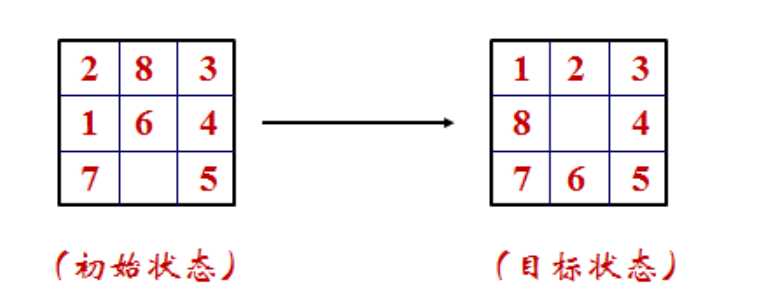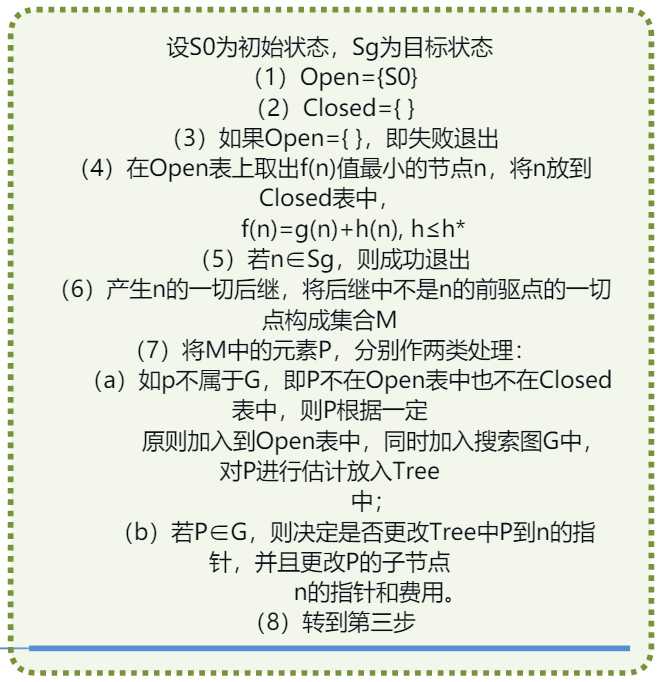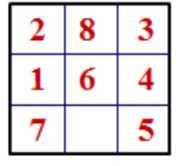A*算法之八数码问题 python解法
系列文章
文章目录
人工智能课程中学习了A*算法,在耗费几小时完成了八数码问题和野人传教士问题之后,决定写此文章来记录一下,避免忘记
问题描述
在3×3的棋盘上,摆有八个棋子,每个棋子上标有1至8的某一数字。棋盘中留有一个空格,空格用0来表示。空格周围的棋子可以移到空格中。要求解的问题是:给出一种初始布局(初始状态)和目标布局(为了使题目简单,设目标状态为123804765),找到一种最少步骤的移动方法,实现从初始布局到目标布局的转变。
也就是移动下图中的方块,使得九宫格可以恢复到目标的状态
A*算法与八数码问题
主要来介绍一下A*算法与该题目如何结合使用,并且使用python语言来实现它
首先对于A*算法,来做一个简单的介绍
那么对于八数码问题,我们需要做的是把他和A*问题联系在一起
这里就需要解决3个问题
- 状态空间的定义
- 各种操作的定义
- 启发式函数的定义
状态空间的定义
首先,本题的状态空间已经很明确了, 就是一个3*3的九宫格,里面充满1-8的数字,加上一个空格,为了方便表示,我们可以把空格用0来表示
那么状态空间就可以用数组来表示(这里使用numpy来表示)
import numpy as np
start_data = np.array([[2, 8, 3], [1, 6, 4], [7, 0, 5]])
end_data = np.array([[1, 2, 3], [8, 0, 4], [7, 6, 5]])
各种操作的定义
对于操作,可以理解为更改状态空间的一些规则
很容易就能想到,如果以每一个元素为对象来讨论,那么它们的上下左右移动最后导致的数组元素交换会稍稍有些复杂,我们不如换一个角度,从空格的移动来考虑
那么操作(转换规则如下所示)
- 空格上移
- 空格下移
- 空格左移
- 空格右移
当然,这些移动还需要判断一些因素,因为有些情况是无法移动的
如上图情况下就不能下移,所以可以编写一个函数来表示各种操作及其产生的影响
注: 下面代码是我自己写的,仅供参考,建议按自己的思路写一遍
def find_zero(num):
tmp_x, tmp_y = np.where(num == 0)
# 返回0所在的x坐标与y坐标
return tmp_x[0], tmp_y[0]
def swap(num_data, direction):
x, y = find_zero(num_data)
num = np.copy(num_data)
if direction == 'left':
if y == 0:
# print('不能左移')
return num
num[x][y] = num[x][y - 1]
num[x][y - 1] = 0
return num
if direction == 'right':
if y == 2:
# print('不能右移')
return num
num[x][y] = num[x][y + 1]
num[x][y + 1] = 0
return num
if direction == 'up':
if x == 0:
# print('不能上移')
return num
num[x][y] = num[x - 1][y]
num[x - 1][y] = 0
return num
if direction == 'down':
if x == 2:
# print('不能下移')
return num
else:
num[x][y] = num[x + 1][y]
num[x + 1][y] = 0
return num
测试一下
num = np.array([[1, 2, 3], [8, 0, 4], [7, 6, 5]])
print('初始状态:')
print(num)
print('-' * 50)
print('左移')
print(swap(num, 'left'))
print('-' * 50)
print('右移')
print(swap(num, 'right'))
print('-' * 50)
print('上移')
print(swap(num, 'up'))
print('-' * 50)
print('下移')
print(swap(num, 'down'))
print('-' * 50)
初始状态:
[[1 2 3]
[8 0 4]
[7 6 5]]
--------------------------------------------------
左移
[[1 2 3]
[0 8 4]
[7 6 5]]
--------------------------------------------------
右移
[[1 2 3]
[8 4 0]
[7 6 5]]
--------------------------------------------------
上移
[[1 0 3]
[8 2 4]
[7 6 5]]
--------------------------------------------------
下移
[[1 2 3]
[8 6 4]
[7 0 5]]
--------------------------------------------------
Process finished with exit code 0
启发式函数的定义
f ( n ) = d ( n ) + w ( n ) f(n)=d(n)+w(n) f(n)=d(n)+w(n)
其中 d ( n ) d(n) d(n)为搜索树的深度,也可以理解为当前是第几轮循环
w ( n ) w(n) w(n)为当前状态到目标状态的实际最小费用的估计值, 在八数码问题中,可以采用放错位置的数字个数,也可以采用数字到正确位置的曼哈顿距离,因人而异
在本文中采用的是 w(n)=放错位置的数字个数
如果将空格位置的正误计算进入,则函数如下
def cal_wcost(num):
return sum(sum(num != end_data))
如果不将空格位置的正误计算进入,则函数如下
def cal_wcost(num):
return sum(sum(num != end_data)) - int(num[1][1] != 0)
也可以用思路最简单的遍历方法
def cal_wcost(num):
''' 计算w(n)的值,及放错元素的个数 :param num: 要比较的数组的值 :return: 返回w(n)的值 '''
con = 0
for i in range(3):
for j in range(3):
tmp_num = num[i][j]
compare_num = end_data[i][j]
if tmp_num != 0:
con += tmp_num != compare_num
return con
A*算法代码框架
先给出我自己定义的代码框架,如果感兴趣的朋友可以用自己的思路去完善它
import queue
opened = queue.Queue() # open表
closed = {
} # close表
def method_a_function():
while len(opened.queue) != 0:
# 取队首元素
node = opened.get()
# 判断是否为目标值.是则返回正确值
1.这里需要一条代码/函数
# 将取出的点加入closed表中
2.这里需要一条代码/函数
# 产生取出元素的一切后继,即执行四个操作
for action in ['left', 'right', 'up', 'down']:
# 创建子节点
3.这里需要一条代码/函数
# 判断是否在closed表中
4.这里需要一条代码/函数
#如果不在close表中,将其加入opened表
5.这里需要一条代码/函数(并且考虑到与opened表中已有元素重复的更新情况)
# 排序
'''为open表进行排序,根据其中的f_loss值'''
6.这里需要一条代码/函数
A*算法代码代码详解
根据上面的框架,我们可以一步一步的来完善它
位置1函数
只要判断一下是否相等就可以了,非常简单
if (node.data == end_data).all():
return node
一、Node类
首先我创建了一个Node类 ,它具有如下一些属性
- data很明显用来记录当前的状态
- step用来记录当前的步数,也就是 g(n) :初始状态到当前状态的距离
- parent用来记录父节点 (这样可以在得到结论之后通过遍历来获取所有的父节点,从而得到最佳路径)
- f_loss用来计算f(n)的值
# 创建Node类 (包含当前数据内容,父节点,步数)
class Node:
f_loss = -1 # 启发值
step = 0 # 初始状态到当前状态的距离(步数)
parent = None, # 父节点
# 用状态和步数构造节点对象
def __init__(self, data, step, parent):
self.data = data # 当前状态数值
self.step = step
self.parent = parent
# 计算f(n)的值
self.f_loss = cal_wcost(data) + step
那么就可以创建初始节点,并且加入opened表中
start_data = np.array([[2, 8, 3], [1, 6, 4], [7, 0, 5]])
opened = queue.Queue() # open表
start_node = Node(start_data, 0, None)
opened.put(start_node)
位置3函数
child_node = Node(swap(node.data, action), node.step + 1, node)
二、data_to_int函数
在这里,我定义closed表为一个字典,因为它的键不能放numpy.array,所以我手动写了一个函数把numpy的数组转换为一个int类型的数字
这里的函数类似于hash函数,不一定要跟我一样,只要保证各种状态产生的结果不同即可
# 将data转化为不一样的数字
def data_to_int(num):
value = 0
for i in num:
for j in i:
value = value * 10 + j
return value
位置2的函数
closed[data_to_int(node.data)] = 1 # 奖取出的点加入closed表中
三、opened表的更新/插入
这里要判断档要插入的节点是否已经在opened表中出现过,如果出现过,则f_loss更小的节点保留
# 编写一个比较当前节点是否在open表中,如果在,根据f(n)的大小来判断去留
def refresh_open(now_node):
''' :param now_node: 当前的节点 :return: '''
tmp_open = opened.queue.copy() # 复制一份open表的内容
for i in range(len(tmp_open)):
'''这里要比较一下node和now_node的区别,并决定是否更新'''
data = tmp_open[i]
now_data = now_node.data
if (data == now_data).all():
data_f_loss = tmp_open[i].f_loss
now_data_f_loss = now_node.f_loss
if data_f_loss <= now_data_f_loss:
return False
else:
print('')
tmp_open[i] = now_node
opened.queue = tmp_open # 更新之后的open表还原
return True
tmp_open.append(now_node)
opened.queue = tmp_open # 更新之后的open表还原
return True
位置4,5的函数
index = data_to_int(child_node.data) # 获取当前节点转换后的index值
if index not in closed:
refresh_open(child_node)
四、opened表排序
按照f_loss从小到大排序,这里我使用最传统的排序方法,有许多可以改进的地方,也可以用python的排序方法结合lambda函数来使用
# 编写一个给open表排序的函数
def sorte_by_floss():
tmp_open = opened.queue.copy()
length = len(tmp_open)
# 排序,从小到大,当一样的时候按照step的大小排序
for i in range(length):
for j in range(length):
if tmp_open[i].f_loss < tmp_open[j].f_loss:
tmp = tmp_open[i]
tmp_open[i] = tmp_open[j]
tmp_open[j] = tmp
if tmp_open[i].f_loss == tmp_open[j].f_loss:
if tmp_open[i].step > tmp_open[j].step:
tmp = tmp_open[i]
tmp_open[i] = tmp_open[j]
tmp_open[j] = tmp
opened.queue = tmp_open
位置6的函数
sorte_by_floss()
五、结果的输出
首先编写output_result函数,依次获取目标节点的父节点,形成一条正确顺序的路径
然后使用循环将这条路径输出
这里为了输出的好看,我使用了prettytable这个库,当然也可以直接输出
def output_result(node):
all_node = [node]
for i in range(node.step):
father_node = node.parent
all_node.append(father_node)
node = father_node
return reversed(all_node)
node_list = list(output_result(result_node))
tb = pt.PrettyTable()
tb.field_names = ['step', 'data', 'f_loss']
for node in node_list:
num = node.data
tb.add_row([node.step, num, node.f_loss])
if node != node_list[-1]:
tb.add_row(['---', '--------', '---'])
print(tb)
总共耗费6轮
+------+-----------+--------+
| step | data | f_loss |
+------+-----------+--------+
| 0 | [[2 8 3] | 4 |
| | [1 6 4] | |
| | [7 0 5]] | |
| --- | -------- | --- |
| 1 | [[2 8 3] | 4 |
| | [1 0 4] | |
| | [7 6 5]] | |
| --- | -------- | --- |
| 2 | [[2 0 3] | 5 |
| | [1 8 4] | |
| | [7 6 5]] | |
| --- | -------- | --- |
| 3 | [[0 2 3] | 5 |
| | [1 8 4] | |
| | [7 6 5]] | |
| --- | -------- | --- |
| 4 | [[1 2 3] | 5 |
| | [0 8 4] | |
| | [7 6 5]] | |
| --- | -------- | --- |
| 5 | [[1 2 3] | 5 |
| | [8 0 4] | |
| | [7 6 5]] | |
+------+-----------+--------+
Process finished with exit code 0
六、代码
可能还是给全代码比较省力
# -*- coding: utf-8 -*-
# @Time : 2020/10/29 21:37
# @Author : Tong Tianyu
# @File : 八数码问题.py
# @Question: A* 算法解决八数码问题
import numpy as np
import queue
import prettytable as pt
''' 初始状态: 目标状态: 2 8 3 1 2 3 1 6 4 8 4 7 5 7 6 5 '''
start_data = np.array([[2, 8, 3], [1, 6, 4], [7, 0, 5]])
end_data = np.array([[1, 2, 3], [8, 0, 4], [7, 6, 5]])
'准备函数'
# 找空格(0)号元素在哪的函数
def find_zero(num):
tmp_x, tmp_y = np.where(num == 0)
# 返回0所在的x坐标与y坐标
return tmp_x[0], tmp_y[0]
# 交换位置的函数 移动的时候要判断一下是否可以移动(是否在底部)
# 记空格为0号,则每次移动一个数字可以看做对空格(0)的移动,总共有四种可能
def swap(num_data, direction):
x, y = find_zero(num_data)
num = np.copy(num_data)
if direction == 'left':
if y == 0:
# print('不能左移')
return num
num[x][y] = num[x][y - 1]
num[x][y - 1] = 0
return num
if direction == 'right':
if y == 2:
# print('不能右移')
return num
num[x][y] = num[x][y + 1]
num[x][y + 1] = 0
return num
if direction == 'up':
if x == 0:
# print('不能上移')
return num
num[x][y] = num[x - 1][y]
num[x - 1][y] = 0
return num
if direction == 'down':
if x == 2:
# print('不能下移')
return num
else:
num[x][y] = num[x + 1][y]
num[x + 1][y] = 0
return num
# 编写一个用来计算w(n)的函数
def cal_wcost(num):
''' 计算w(n)的值,及放错元素的个数 :param num: 要比较的数组的值 :return: 返回w(n)的值 '''
# return sum(sum(num != end_data)) - int(num[1][1] != 0)
con = 0
for i in range(3):
for j in range(3):
tmp_num = num[i][j]
compare_num = end_data[i][j]
if tmp_num != 0:
con += tmp_num != compare_num
return con
# 将data转化为不一样的数字 类似于hash
def data_to_int(num):
value = 0
for i in num:
for j in i:
value = value * 10 + j
return value
# 编写一个给open表排序的函数
def sorte_by_floss():
tmp_open = opened.queue.copy()
length = len(tmp_open)
# 排序,从小到大,当一样的时候按照step的大小排序
for i in range(length):
for j in range(length):
if tmp_open[i].f_loss < tmp_open[j].f_loss:
tmp = tmp_open[i]
tmp_open[i] = tmp_open[j]
tmp_open[j] = tmp
if tmp_open[i].f_loss == tmp_open[j].f_loss:
if tmp_open[i].step > tmp_open[j].step:
tmp = tmp_open[i]
tmp_open[i] = tmp_open[j]
tmp_open[j] = tmp
opened.queue = tmp_open
# 编写一个比较当前节点是否在open表中,如果在,根据f(n)的大小来判断去留
def refresh_open(now_node):
''' :param now_node: 当前的节点 :return: '''
tmp_open = opened.queue.copy() # 复制一份open表的内容
for i in range(len(tmp_open)):
'''这里要比较一下node和now_node的区别,并决定是否更新'''
data = tmp_open[i]
now_data = now_node.data
if (data == now_data).all():
data_f_loss = tmp_open[i].f_loss
now_data_f_loss = now_node.f_loss
if data_f_loss <= now_data_f_loss:
return False
else:
print('')
tmp_open[i] = now_node
opened.queue = tmp_open # 更新之后的open表还原
return True
tmp_open.append(now_node)
opened.queue = tmp_open # 更新之后的open表还原
return True
# 创建Node类 (包含当前数据内容,父节点,步数)
class Node:
f_loss = -1 # 启发值
step = 0 # 初始状态到当前状态的距离(步数)
parent = None, # 父节点
# 用状态和步数构造节点对象
def __init__(self, data, step, parent):
self.data = data # 当前状态数值
self.step = step
self.parent = parent
# 计算f(n)的值
self.f_loss = cal_wcost(data) + step
'算法'
opened = queue.Queue() # open表
start_node = Node(start_data, 0, None)
opened.put(start_node)
closed = {
} # close表
def method_a_function():
con = 0
while len(opened.queue) != 0:
node = opened.get()
if (node.data == end_data).all():
print(f'总共耗费{con}轮')
return node
closed[data_to_int(node.data)] = 1 # 奖取出的点加入closed表中
# 四种移动方法
for action in ['left', 'right', 'up', 'down']:
# 创建子节点
child_node = Node(swap(node.data, action), node.step + 1, node)
index = data_to_int(child_node.data)
if index not in closed:
refresh_open(child_node)
# 排序
'''为open表进行排序,根据其中的f_loss值'''
sorte_by_floss()
con += 1
result_node = method_a_function()
def output_result(node):
all_node = [node]
for i in range(node.step):
father_node = node.parent
all_node.append(father_node)
node = father_node
return reversed(all_node)
node_list = list(output_result(result_node))
tb = pt.PrettyTable()
tb.field_names = ['step', 'data', 'f_loss']
for node in node_list:
num = node.data
tb.add_row([node.step, num, node.f_loss])
if node != node_list[-1]:
tb.add_row(['---', '--------', '---'])
print(tb)
今天的文章A*算法之八数码问题 python解法分享到此就结束了,感谢您的阅读。
版权声明:本文内容由互联网用户自发贡献,该文观点仅代表作者本人。本站仅提供信息存储空间服务,不拥有所有权,不承担相关法律责任。如发现本站有涉嫌侵权/违法违规的内容, 请发送邮件至 举报,一经查实,本站将立刻删除。
如需转载请保留出处:https://bianchenghao.cn/13119.html



